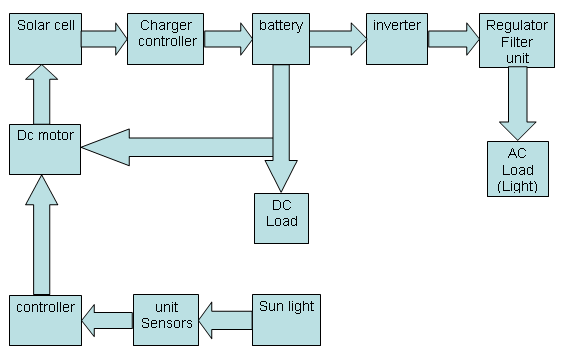Introduction:
The idea of project is how to use photovoltaic to produce constant and alternative electricity to light. the power of this project is from 500w to1000w which is provide enough electrical energy for lighting a single house, special component are used in this project :-
Solar cell unit, batteries, charge controller, inverter, filter and regulator unit, position controller, dc motor and sensors.
Project advantage:
found a renewable energy, since the normal energy goes to end.
using pour and clear energy source.
using a friendly source energy of the nature.
Useful for the areas have no electrical source.
this energy independent of political situation.
Block diagram of project.

Figure : block diagram of lighting using solar cells.
The following steps summarize the work principle for the project and describe the issues of each block in the block diagram :
Charge controller control the flow of voltage to the battery, and the voltage storage in the battery, which is provide dc voltage to dc load and inverter
inverter convert 12 Volt DC from battery to 220 AC voltage .
AC 220V need regulator and filter to make a smother and acceptable sin wave, for AC load.
sun light effect the unit sensor which give a signal to the controller, which detect the right position for largest sun shine by the DC motor .
The Need for Solar Cells
The development of solar cell use in Australia has been stimulated by:
the need for low maintenance, long lasting sources of electricity suitable for places remote from both the main electricity grid and from people; eg satellites, remote site water pumping, outback telecommunications stations and lighthouses;
the need for cost effective power supplies for people remote from the main electricity grid; eg Aboriginal settlements, outback sheep and cattle stations, and some home sites in grid connected areas.
the need for non polluting and silent sources of electricity; eg tourist sites, caravans and campers
the need for a convenient and flexible source of small amounts of power; eg calculators, watches, light meters and cameras;
the need for renewable and sustainable power, as a means of reducing global warming.
Together, these needs have produced a growing market for photovoltaic which has stimulated innovation. As the market has grown, the cost of cells and systems has declined, and new applications have been discovered.

